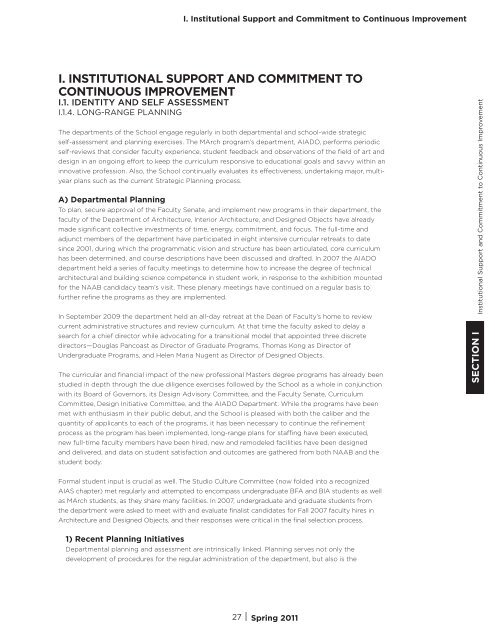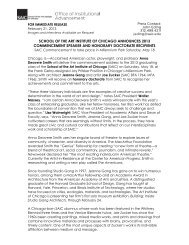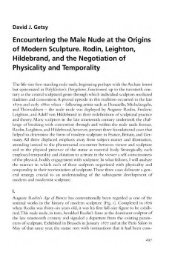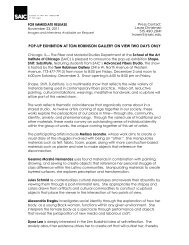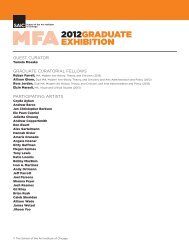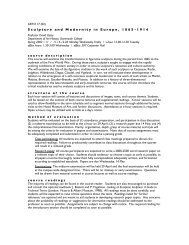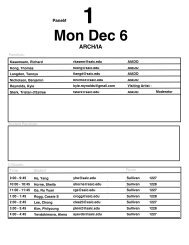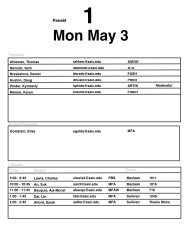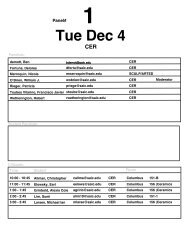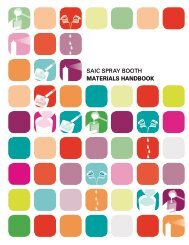i. institutional support and commitment to continuous improvement
i. institutional support and commitment to continuous improvement
i. institutional support and commitment to continuous improvement
Create successful ePaper yourself
Turn your PDF publications into a flip-book with our unique Google optimized e-Paper software.
I. Institutional Support <strong>and</strong> Commitment <strong>to</strong> Continuous Improvement<br />
I. INSTITUTIONAL SUPPORT AND COMMITMENT TO<br />
CONTINUOUS IMPROVEMENT<br />
I.1. IDENTITY AND SELF ASSESSMENT<br />
I.1.4. LONG-RANGE PLANNING<br />
The departments of the School engage regularly in both departmental <strong>and</strong> school-wide strategic<br />
self-assessment <strong>and</strong> planning exercises. The MArch program’s department, AIADO, performs periodic<br />
self-reviews that consider faculty experience, student feedback <strong>and</strong> observations of the field of art <strong>and</strong><br />
design in an ongoing effort <strong>to</strong> keep the curriculum responsive <strong>to</strong> educational goals <strong>and</strong> savvy within an<br />
innovative profession. Also, the School continually evaluates its effectiveness, undertaking major, multi-<br />
year plans such as the current Strategic Planning process.<br />
A) Departmental Planning<br />
To plan, secure approval of the Faculty Senate, <strong>and</strong> implement new programs in their department, the<br />
faculty of the Department of Architecture, Interior Architecture, <strong>and</strong> Designed Objects have already<br />
made significant collective investments of time, energy, <strong>commitment</strong>, <strong>and</strong> focus. The full-time <strong>and</strong><br />
adjunct members of the department have participated in eight intensive curricular retreats <strong>to</strong> date<br />
since 2001, during which the programmatic vision <strong>and</strong> structure has been articulated, core curriculum<br />
has been determined, <strong>and</strong> course descriptions have been discussed <strong>and</strong> drafted. In 2007 the AIADO<br />
department held a series of faculty meetings <strong>to</strong> determine how <strong>to</strong> increase the degree of technical<br />
architectural <strong>and</strong> building science competence in student work, in response <strong>to</strong> the exhibition mounted<br />
for the NAAB c<strong>and</strong>idacy team’s visit. These plenary meetings have continued on a regular basis <strong>to</strong><br />
further refine the programs as they are implemented.<br />
In September 2009 the department held an all-day retreat at the Dean of Faculty’s home <strong>to</strong> review<br />
current administrative structures <strong>and</strong> review curriculum. At that time the faculty asked <strong>to</strong> delay a<br />
search for a chief direc<strong>to</strong>r while advocating for a transitional model that appointed three discrete<br />
direc<strong>to</strong>rs—Douglas Pancoast as Direc<strong>to</strong>r of Graduate Programs, Thomas Kong as Direc<strong>to</strong>r of<br />
Undergraduate Programs, <strong>and</strong> Helen Maria Nugent as Direc<strong>to</strong>r of Designed Objects.<br />
The curricular <strong>and</strong> financial impact of the new professional Masters degree programs has already been<br />
studied in depth through the due diligence exercises followed by the School as a whole in conjunction<br />
with its Board of Governors, its Design Advisory Committee, <strong>and</strong> the Faculty Senate, Curriculum<br />
Committee, Design Initiative Committee, <strong>and</strong> the AIADO Department. While the programs have been<br />
met with enthusiasm in their public debut, <strong>and</strong> the School is pleased with both the caliber <strong>and</strong> the<br />
quantity of applicants <strong>to</strong> each of the programs, it has been necessary <strong>to</strong> continue the refinement<br />
process as the program has been implemented, long-range plans for staffing have been executed,<br />
new full-time faculty members have been hired, new <strong>and</strong> remodeled facilities have been designed<br />
<strong>and</strong> delivered, <strong>and</strong> data on student satisfaction <strong>and</strong> outcomes are gathered from both NAAB <strong>and</strong> the<br />
student body.<br />
Formal student input is crucial as well. The Studio Culture Committee (now folded in<strong>to</strong> a recognized<br />
AIAS chapter) met regularly <strong>and</strong> attempted <strong>to</strong> encompass undergraduate BFA <strong>and</strong> BIA students as well<br />
as MArch students, as they share many facilities. In 2007, undergraduate <strong>and</strong> graduate students from<br />
the department were asked <strong>to</strong> meet with <strong>and</strong> evaluate finalist c<strong>and</strong>idates for Fall 2007 faculty hires in<br />
Architecture <strong>and</strong> Designed Objects, <strong>and</strong> their responses were critical in the final selection process.<br />
1) Recent Planning Initiatives<br />
Departmental planning <strong>and</strong> assessment are intrinsically linked. Planning serves not only the<br />
development of procedures for the regular administration of the department, but also is the<br />
27 | Spring 2011<br />
SECTION I Institutional Support <strong>and</strong> Commitment <strong>to</strong> Continuous Improvement


